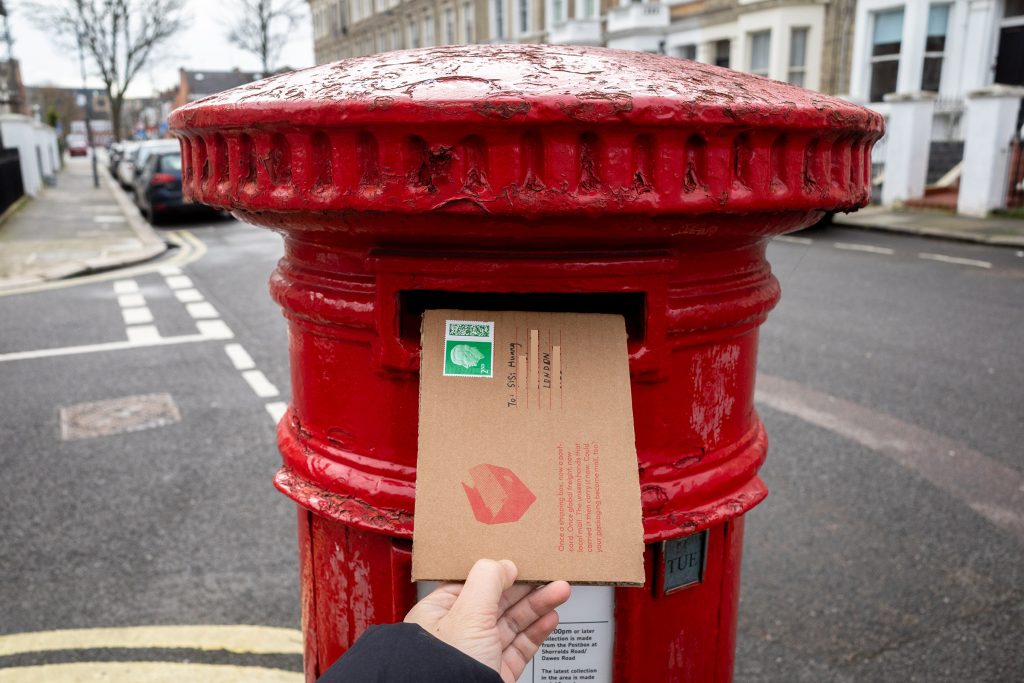1 Line of enquiry
How can the visual and physical properties of discarded corrugated cardboard boxes offer a more nuanced understanding of the distribution system? By sending and receiving postcards made from these discarded boxes, how might I generate alternative knowledge of this system?
2 Project proposal
Corrugated cardboard, a primary packaging material, is often overlooked and discarded once a delivery is complete. This project reclaims discarded shipping boxes by transforming them into postcards, screen-printed with images of the original boxes they came from. By reintroducing this material into the mailing system, which now carries messages instead of consumer goods, the project invites reflection on the designed disposability of packaging and whether alternative systems for packaging and shipping are possible.
By collecting my own and others’ shipping boxes, I have built an archive of discarded corrugated boxes, each with unique visual and physical properties shaped by its journey and purpose.
Through analysing material, shipping labels, logistics stickers and marketing messages, this project reconstructs narratives beyond what a tracking page reveals. These findings are published on postcards, cut directly from the boxes, each series telling the story of its source material. Once mailed, these postcards re-enter the distribution system, accumulating new traces – stamps, marks and wear – further embedding themselves in the logistics network. The audience is invited to engage by responding or forwarding the postcards, extending the cardboard’s journey as a message rather than mere packaging.
Input: seven to eight boxes, sourced from domestic shipments within the UK and international shipments from China and the U.S.
Audience: primarily online and international shoppers, and they will interact with the postcards by:
- Receiving and tracing: sharing their mailing address to receive a postcard, examining the screen-printed images of the original shipping boxes and speculating on their past journeys and transformations.
- Activate a new journey: forwarding the postcard to someone else or mailing back a piece of their own discarded cardboard, physically extending the cardboard’s journey as a message rather than waste.
3 Updated annotated bibliography
Including at least 10 new text and practice references.
Offenhuber, D. (2023) Waste Is Information: Infrastructure Legibility and Governance. Cambridge: The MIT Press.
Offenhuber (2023) argues that waste is a process of losing information, but sorting can restore some of that lost meaning by making hidden stories visible again. A discarded cardboard box has seemingly fulfilled its purpose of protecting and transporting goods. Yet, it carries layers of information through shipping labels, sorting stickers and hand-written notes – traces of a journey that is mostly illegible to consumers.
Barcodes, numeric codes, airport codes in the shipping labels, and logistic stickers are designed for efficiency rather than human legibility, reinforcing the idea that “the most profound technologies are those that disappear” (Weiser, 1991). But what if we make them readable? How could cardboard act as a documentation for the global distribution system rather than waste, similar to how landfills serve as an archaeological site of consumption, as Offenhuber (2023) suggests? What could we learn about the invisible networks that shape global distribution by questioning what is hidden and what is exposed in the logistics and waste system surrounding these cardboard boxes?
Olbrich, J. Paper police. https://no-institute.com/
Olbrich, also known as “Paper Police,” scavenges discarded paper and cardboard to recover overlooked printed materials, often repackaging and redistributing them as newly valued objects. His approach to reclaiming waste through artistic intervention resonates with my practice of repurposing discarded shipping boxes into postcards, repositioning them as information carriers rather than mere refuse.
Patterson, C. (2015) Bottom of the Lake Book. Available at: https://www.christianpatterson.com/bottom-of-the-lake-book/ (Accessed: 12 Feb 2025).
Patterson reinterprets his family telephone book for his hometown by adding the found markings, personal photos and drawings, transferring a mundane directory into an alternative archive of place and memory. Similarly, I intervene in the discarded cardboard boxes by turning them into postcards, applying labels and stickers that document the invisible labour and reframe corporate messaging. Both approaches uncover hidden narratives within found materials, inviting audience to engage with overlooked history embedded in every objects.
Anderson, S. (2021) Mail Art and Fluxus: An Antic Exhibition from 1982. Available at: https://www.on-curating.org/issue-51-reader/mail-art-and-fluxus-an-antic-exhibition-from-1982.html (Accessed: Feb 17 2025).
Turning shipping boxes into postcards and reintroducing them into the postal system mirrors the participatory ethos of mail art. By screen printing messages and pasting images directly onto the cardboard, the material itself becomes the subject rather than simply a disposable container. This aligns with Fluxus’s strategies of repurposing everyday materials to disrupt conventional systems of communication and value.
Walead Beshty Studios Inc. (2019). FedEx Works. Available at: https://www.actionstakenunderthefictitiousnamewaleadbeshtystudiosinc.com/fedex-works-2007 (Accessed: Feb 17 2025).
Beshty’s FedEx series custom-builds and ships glass boxes at standard shipping box sizes, deliberately subjecting them to the vulnerability of global transit. The resulting fractures reveal the often-invisible traces left by global logistics networks. This approach of designing objects that register systemic imprints aligns with my project’s method of reintroducing cardboard into the shipping system, allowing its journey to be documented, marked and altered. Similar to Besthy’s glass works, my postcards act as both a material record of transit and a critique of the infrastructure that shapes their movement.
Ohringer, S. (ed.) (2023) Waybill. TEU Press. Volume One.
